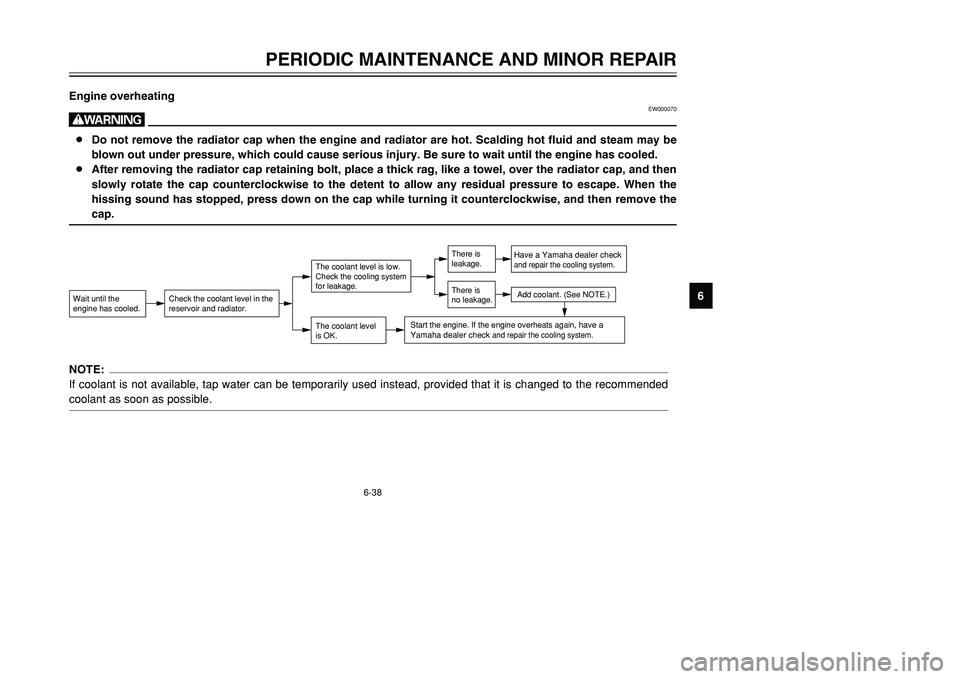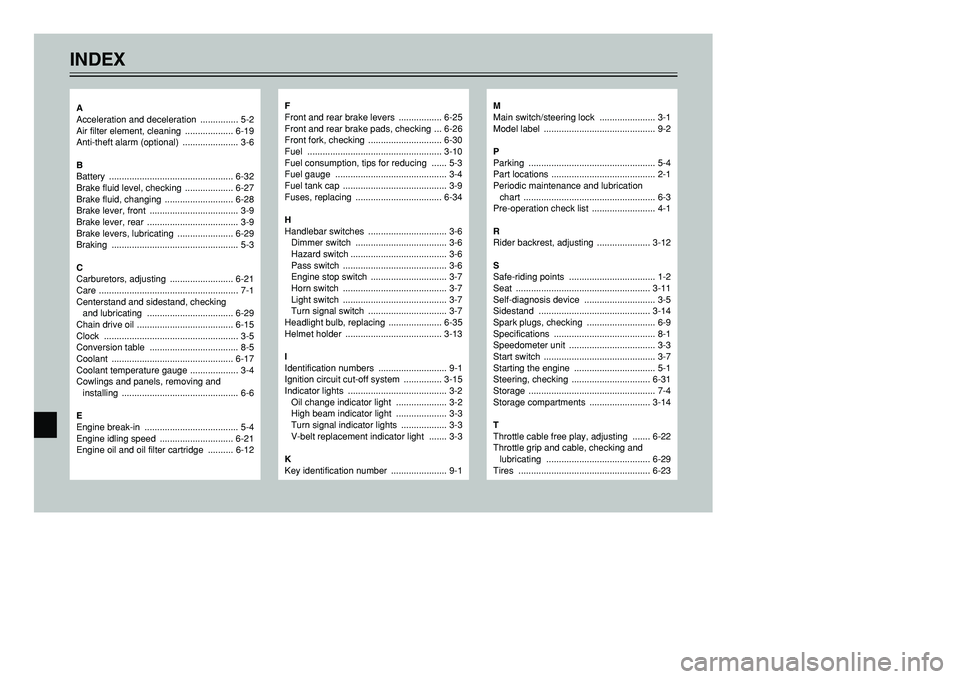check engine YAMAHA TMAX 2002 Owner's Manual
[x] Cancel search | Manufacturer: YAMAHA, Model Year: 2002, Model line: TMAX, Model: YAMAHA TMAX 2002Pages: 102, PDF Size: 1.67 MB
Page 65 of 102

6-21
PERIODIC MAINTENANCE AND MINOR REPAIR
6
EAU00630
Adjusting the carburetorsCarburetors, adjustingThe carburetors are important parts
of the engine and require very
sophisticated adjustment. Therefore,
most carburetor adjustments should
be left to a Yamaha dealer, who has
the necessary professional knowl-
edge and experience. The adjust-
ment described in the following sec-
tion, however, may be serviced by
the owner as part of routine mainte-
nance.
EC000095
cCThe carburetors have been set and
extensively tested at the Yamaha
factory. Changing these settings
without sufficient technical knowl-
edge may result in poor perfor-
mance of or damage to the engine.
NOTE:
The engine is warm when it quickly
responds to the throttle.4. Check the engine idling speed
and, if necessary, adjust it to
specification by turning the throt-
tle stop screw. To increase the
engine idling speed, turn the
screw in direction a. To
decrease the engine idling
speed, turn the screw in direction
b.
1a
b
1. Throttle stop screw
EAU03821
Adjusting the engine idling
speedEngine idling speedThe engine idling speed must be
checked and, if necessary, adjusted
as follows at the intervals specified in
the periodic maintenance and lubrica-
tion chart.NOTE:
A diagnostic tachometer is needed to
make this adjustment.1. Remove panel B. (See page 6-7
for panel removal and installation
procedures.)
2. Attach the tachometer to the
spark plug lead.
3. Start the engine and warm it up
for several minutes at 1,000–
2,000 r/min while occasionally
revving it to 4,000–5,000 r/min.
Engine idling speed:
1,150–1,200 r/min
5GJ-9-E1 9/4/01 1:27 PM Page 64
Page 66 of 102

6-22
PERIODIC MAINTENANCE AND MINOR REPAIR
6
NOTE:
If the specified idling speed cannot
be obtained as described above,
have a Yamaha dealer make the
adjustment.5. Install the panel.
EAU00637
Adjusting the valve
clearanceValve clearance, adjustingThe valve clearance changes with
use, resulting in improper air-fuel mix-
ture and/or engine noise. To prevent
this from occurring, the valve clear-
ance must be adjusted by a Yamaha
dealer at the intervals specified in the
periodic maintenance and lubrication
chart.
EAU00635
Adjusting the throttle cable
free playThrottle cable free play, adjustingThe throttle cable free play should
measure 3–5 mm at the throttle grip.
Periodically check the throttle cable
free play and, if necessary, have a
Yamaha dealer adjust it.
a
a. Throttle cable free play
5GJ-9-E1 9/4/01 1:27 PM Page 65
Page 75 of 102

6-31
PERIODIC MAINTENANCE AND MINOR REPAIR
6
EAU00794
Checking the steeringSteering, checkingWorn or loose steering bearings may
cause danger. Therefore, the opera-
tion of the steering must be checked
as follows at the intervals specified in
the periodic maintenance and lubrica-
tion chart.
1. Place a stand under the engine
to raise the front wheel off the
ground.
EW000115
wSecurely support the scooter so
that there is no danger of it falling
over.
EAU01144
Checking the wheel bearingsWheel bearings, checkingThe front and rear wheel bearings
must be checked at the intervals
specified in the periodic maintenance
and lubrication chart. If there is play
in the wheel hub or if the wheel does
not turn smoothly, have a Yamaha
dealer check the wheel bearings.
2. Hold the lower ends of the front
fork legs and try to move them
forward and backward. If any
free play can be felt, have a
Yamaha dealer check or repair
the steering.
5GJ-9-E1 9/4/01 1:27 PM Page 74
Page 81 of 102

6-37
PERIODIC MAINTENANCE AND MINOR REPAIR
6
EAU02990
Troubleshooting chartsTroubleshooting chartsStarting problems or poor engine performance
EW000125
wKeep away open flames and do not smoke while checking or working on the fuel system.Check the fuel level in
the fuel tank.1. Fuel
There is enough fuel.
There is no fuel.
Check the compression.
Supply fuel.
The engine does not start.
Check the compression.
Operate the electric starter.2. Compression
There is compression.
There is no compression.
Check the ignition.
Have a Yamaha dealer
check the vehicle.
Remove the spark plugs
and check the electrodes.3. Ignition
Wipe off with a dry cloth and correct the
spark plug gaps, or replace the spark plugs.
Have a Yamaha dealer check the vehicle.
The engine does not start.
Have a Yamaha dealer
check the vehicle.
Operate the electric starter.4. Battery
The engine turns over
quickly.
The engine turns over
slowly.DryWet
The engine does not start.
Check the battery.Open the throttle halfway and operate
the electric starter.
The battery is good.Check the battery lead connections,
and charge the battery if necessary.
5GJ-9-E1 9/4/01 1:27 PM Page 80
Page 82 of 102

6-38
PERIODIC MAINTENANCE AND MINOR REPAIR
6 Engine overheating
EW000070
w8Do not remove the radiator cap when the engine and radiator are hot. Scalding hot fluid and steam may be
blown out under pressure, which could cause serious injury. Be sure to wait until the engine has cooled.
8After removing the radiator cap retaining bolt, place a thick rag, like a towel, over the radiator cap, and then
slowly rotate the cap counterclockwise to the detent to allow any residual pressure to escape. When the
hissing sound has stopped, press down on the cap while turning it counterclockwise, and then remove the
cap.Wait until the
engine has cooled.
Check the coolant level in the
reservoir and radiator.
The coolant level
is OK.The coolant level is low.
Check the cooling system
for leakage.
Have a Yamaha dealer checkand repair the cooling system.Add coolant. (See NOTE.)
Start the engine. If the engine overheats again,
have a
Yamaha dealer check
and repair the cooling system.
There is
leakage.
There is
no leakage.
NOTE:
If coolant is not available, tap water can be temporarily used instead, provided that it is changed to the recommended
coolant as soon as possible.
5GJ-9-E1 9/4/01 1:27 PM Page 81
Page 99 of 102

INDEX
F
Front and rear brake levers ................. 6-25
Front and rear brake pads, checking ... 6-26
Front fork, checking ............................. 6-30
Fuel ..................................................... 3-10
Fuel consumption, tips for reducing ...... 5-3
Fuel gauge ............................................ 3-4
Fuel tank cap ......................................... 3-9
Fuses, replacing .................................. 6-34
H
Handlebar switches ............................... 3-6
Dimmer switch .................................... 3-6
Hazard switch ...................................... 3-6
Pass switch ......................................... 3-6
Engine stop switch .............................. 3-7
Horn switch ......................................... 3-7
Light switch ......................................... 3-7
Turn signal switch ............................... 3-7
Headlight bulb, replacing ..................... 6-35
Helmet holder ...................................... 3-13
I
Identification numbers ........................... 9-1
Ignition circuit cut-off system ............... 3-15
Indicator lights ....................................... 3-2
Oil change indicator light .................... 3-2
High beam indicator light .................... 3-3
Turn signal indicator lights .................. 3-3
V-belt replacement indicator light ....... 3-3
K
Key identification number ...................... 9-1
M
Main switch/steering lock ...................... 3-1
Model label ............................................ 9-2
P
Parking .................................................. 5-4
Part locations ......................................... 2-1
Periodic maintenance and lubrication
chart .................................................... 6-3
Pre-operation check list ......................... 4-1
R
Rider backrest, adjusting ..................... 3-12
S
Safe-riding points .................................. 1-2
Seat ..................................................... 3-11
Self-diagnosis device ............................ 3-5
Sidestand ............................................ 3-14
Spark plugs, checking ........................... 6-9
Specifications ........................................ 8-1
Speedometer unit .................................. 3-3
Start switch ............................................ 3-7
Starting the engine ................................ 5-1
Steering, checking ............................... 6-31
Storage .................................................. 7-4
Storage compartments ........................ 3-14
T
Throttle cable free play, adjusting ....... 6-22
Throttle grip and cable, checking and
lubricating ......................................... 6-29
Tires .................................................... 6-23
A
Acceleration and deceleration ............... 5-2
Air filter element, cleaning ................... 6-19
Anti-theft alarm (optional) ...................... 3-6
B
Battery ................................................. 6-32
Brake fluid level, checking ................... 6-27
Brake fluid, changing ........................... 6-28
Brake lever, front ................................... 3-9
Brake lever, rear .................................... 3-9
Brake levers, lubricating ...................... 6-29
Braking .................................................. 5-3
C
Carburetors, adjusting ......................... 6-21
Care ....................................................... 7-1
Centerstand and sidestand, checking
and lubricating .................................. 6-29
Chain drive oil ...................................... 6-15
Clock ..................................................... 3-5
Conversion table ................................... 8-5
Coolant ................................................ 6-17
Coolant temperature gauge ................... 3-4
Cowlings and panels, removing and
installing .............................................. 6-6
E
Engine break-in ..................................... 5-4
Engine idling speed ............................. 6-21
Engine oil and oil filter cartridge .......... 6-12
5GJ-9-E1 9/4/01 1:27 PM Page 98